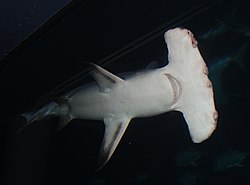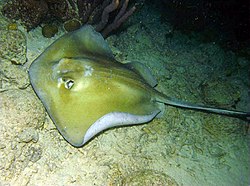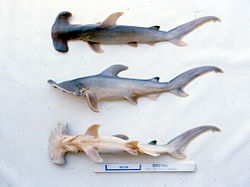Great hammerhead shark
The great hammerhead (Sphyrna mokarran) is the largest species of the Hammerhead shark group.
| Great Hammerhead Shark | |
|---|---|

| |
| A large Great hammerhead feeding, in Bahamas. | |
| Conservation status | |
| Scientific classification | |
| Kingdom: | |
| Phylum: | |
| Class: | |
| Subclass: | |
| Order: | |
| Family: | |
| Genus: | |
| Species: | S. mokarran
|

| |
| Range of the Great Hammerhead Shark (In blue) | |
Description
Hammer
Like all other hammerhead sharks, great hammerheads have a streamlined body and a "hammer" on their heads. They have often been confused with the scalloped hammerhead and the smooth hammerhead shark. However, adult great hammerhead sharks can be identified by their wide cephalofoil, which has an almost straight margin at the front, and by their first dorsal fin, which is tall and sickle-shaped.
The cephalofoil is usually around 1 to 1.5 meters long. The top part of the great hammerhead is gray-brown or green, and the belly is white.
Size
Great hammerhead sharks are usually around 2.85 to 5.5 meters (9.4 to 18 feet) long. However, the longest ever found was 6.1 meters (20 feet) long.
Great hammerheads usually weigh around 450 kg (992 pounds). The heaviest ever found was a female caught off Boca Grande, Florida. She was 4.4 meters (14.4 feet) long and weighed 580 kg (1279 pounds). However, the female weighed this much because it was pregnant.
Home
The great hammerhead shark is found in tropical waters around the world, between the latitudes 40°N to 37°S.
In the Atlantic Ocean it is found from North Carolina to Uruguay, including the Gulf of Mexico and the Caribbean Sea, and from Morocco to Senegal, and the Mediterranean Sea.
It is found all along the rim of the Indian Ocean, and in the Pacific Ocean from the Ryukyu Islands to Australia, New Caledonia, and French Polynesia, and from southern Baja California to Peru.
It's said to be found off Gambia, Guinea, Mauritania, Sierra Leone, and Western Sahara, but this has not been confirmed.
Great Hammerhead Sharks can be found from inshore waters which are less than 1 meter deep. They can also swim at a depth of 80 meters offshore. They live mainly in coral reefs, but have been found in lagoons and deep water near land.
Behaviour
Even though great hammerheads are apex predators, bull sharks have been seen killing great hammerhead pups.
Yellow jacks have been seen rubbing themselves against great hammerhead sharks, probably to get rid of parasites. Pilot fish have been seen swimming with great hammerheads.
Reproduction
Great hammerheads are viviparous, meaning they give live birth. Females are pregnant for around 11 months before giving birth to a litter of 6 to 56 pups. When they are born, the pups are around 50–70 cm (20 to 28 in) long.
Males mature when they are about 2.3 to 2.8 meters long, and weigh around 51 kg. Females mature when they are about 2.5 to 3 meters long, and weigh around 41 kg.
Great Hammerhead Sharks live for around 20–30 years, but the oldest Great Hammerhead Shark ever found was said to be 40–50 years old.
Feeding
Great hammerhead sharks are known to hunt at dawn and at dusk. They feed on crustaceans like crabs and lobsters, mollusks like squid and octopuses, bony fish like tarpon, sardines, herrings, sea catfish, toadfish, porgies, jacks, croakers, groupers, flatfish, boxfish, and porcupine fish. They also eat other sharks, like smoothhounds and grey reef sharks. Great Hammerhead Sharks have been known to eat others of their kind.
Great hammerhead sharks' favourite prey are rays and skates; its favourite type of ray are stingrays. The venomous spines of the stingrays don't seem to affect them, because a great hammerhead shark caught off Florida had 96 venomous spines found in and around its mouth.
The cephalofoil of the great hammerhead shark is said to be used to pin stingrays down, because a great hammerhead shark was found attacking a stingray in the Bahamas. The great hammerhead first pinned the stingray down by hitting the stingray with its cephalofoil; then it grabbed the stingray in its jaws and began shaking its head rapidly in order to rip the ray apart.
Another great hammerhead shark was found attacking a spotted eagle ray in open water. The Great Hammerhead Shark first bit off one of the ray's pectoral fins; then it pinned the ray down with its cephalofoil and ate the ray head-first.
Human interactions
Although they have been said[by whom?] to be dangerous towards humans, Great Hammerhead Sharks rarely ever attack humans. Divers have reported that Great Hammerhead Sharks are shy and avoid humans, but there have been reports of Great Hammerhead Sharks approaching divers closely and even chasing them.
In 2009, the International Shark Attack File listed 34 attacks caused by a shark which belonged in the Sphyrna genus. However, it is not confirmed if the shark was a Great Hammerhead or not. The great hammerhead shark has been confirmed to be responsible for one provoked attack.
Conservation status
The great hammerhead shark has been listed as endangered by the International Union for the Conservation of Nature (IUCN), because of fishing for its fins, which are made into shark fin soup; for its skin, which is made into leather; and their liver oil for vitamins. Populations of the Great Hammerhead Shark have decreased by 50% because of fishing.
Great Hammerhead Shark Media
References
- BBC-Great Hammerhead Shark Archived 2012-06-19 at the Wayback Machine
- Great Hammerhead Shark-Cool Facts and Information Archived 2012-09-01 at the Wayback Machine
- FLMNH- Great hammerhead shark Archived 2016-01-24 at the Wayback Machine
- ↑ "Sphyrna (hammerhead shark)".
{{cite web}}: Unknown parameter|published=ignored (help)[dead link]










